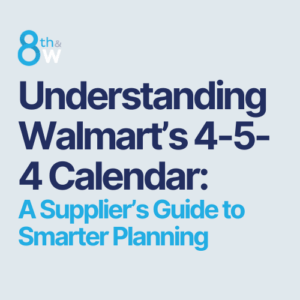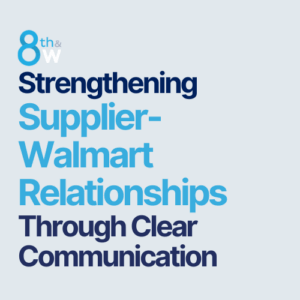If you’re a supplier to Walmart, understanding the current status and evolution of Project Gigaton is crucial — not just for compliance but for aligning your sustainability strategy, accessing the right resources, and maximizing the business benefits.
What is Project Gigaton?
Project Gigaton is Walmart’s signature supply-chain sustainability initiative, launched in 2017, designed to work with suppliers and other partners to reduce, avoid or sequester one billion metric tons (a “gigaton”) of greenhouse-gas (GHG) emissions from the product value chain by 2030. It specifically engages suppliers on actions across their operations and supply networks, not only in Walmart’s direct stores or transport fleets.
What’s the Latest with Project Gigaton?
Since the original blog in 2022, here are key updates:
- Goal Achieved Early
Walmart announced in February 2024 that its suppliers had reported projects that are expected to exceed the 1 billion-metric-ton goal six years ahead of the 2030 target.
In short: the target has been hit, but the work continues. - Supplier Participation
As of early 2024 the number of participating suppliers has grown to more than 5,900. Reports also indicate that in FY2023, suppliers participating in Project Gigaton represented ~75 % of U.S. product net-sales dollars for Walmart. - Shift to Next-Phase Focus
With the one-gigaton goal achieved early, Walmart is refocusing Project Gigaton toward deeper and more challenging emission-cutting tasks — especially in the supply chain’s Scope 3 emissions (the most difficult “upstream” and “downstream” emissions).
Walmart also continues to push its operational (Scopes 1 & 2) emissions target: zero operational emissions by 2040.
- Evolving Supplier Requirements & Recognition
In 2024/25, the bar for the “Giga Guru” recognition (top tier of supplier recognition) has been raised. For example, suppliers are expected to share more complete disclosures (Scope 1 & 2 footprint, perhaps relevant Scope 3 categories, renewable electricity consumption).
Reporting and transparency are increasingly important. Some analysts note that supplier reporting quality and third-party validation may bear on procurement decisions.
Why Is Project Gigaton Important for Suppliers?
For a supplier, participating in this initiative offers multiple business and sustainability benefits. Key reasons include:
- It signals alignment with Walmart’s strategic priorities. As the retailer’s sustainability goals mature, suppliers seen as “on track” may gain competitive advantage.
- Many initiatives that reduce emissions also reduce cost or risk (e.g., energy efficiency, packaging optimization, waste reduction).
- Reporting and recognition may open access to financing programs, preferred supplier status, or inclusion in sustainability-focused programs.
- With regulatory and stakeholder pressure increasing globally around emissions disclosure (especially Scope 3), being ahead of the curve is beneficial.
- Even though the 1 billion-ton milestone has been reached, the underlying systems, tools and reporting processes remain relevant—suppliers need to stay engaged, not drop off.
Not sure how your brand fits into Walmart’s sustainability goals?
We helped Ocean’s Halo build a strategy that aligned with Walmart’s expectations and created real retail impact.
Let’s chat about what’s possible for your team. Fill out the form below to get started.
The Six Pillars of Project Gigaton (unchanged in structure but evolved in expectation)
Suppliers were invited to focus efforts across six “pillars” of opportunity — you still select one or more based on your business relevance:
- Energy — Energy efficiency, switching to renewables, optimizing fuel consumption in operations.
- Nature — Addressing deforestation, sustainable agriculture, restoration of landscapes, soil health.
- Waste — Reducing food waste, material waste, landfill diversion, optimizing operations.
- Product Use & Design — Using sustainable/recycled materials, extending product lifetime, designing for lower impact.
- Packaging — Lightweight, recyclable materials, reusable packaging, circular-economy models.
- Transportation — Reducing mileage, optimizing logistics, switching to low-/zero-emission transport.
Note: While the pillars remain relevant, the expectations for reporting, measurement and supplier disclosures in those pillars have increased.
How to Participate
If you’re not already engaged — or want to ensure you’re fully aligned — here is a refreshed step-by-step guide:
- Register through the Walmart Sustainability Hub. Register in the portal dedicated to Project Gigaton and connect your supplier profile.
- Define your goals and action plan. Decide which pillar(s) you will focus on. Set realistic, measurable reduction targets (ideally aligned to science-based or credible frameworks).
- Take action and implement initiatives. Deploy projects that drive measurable emissions reductions or avoidance, e.g., energy upgrades, packaging redesign, agricultural improvements.
- Report annually (or per Walmart’s cycle). Suppliers must submit reported reductions/avoidances via the portal (or via the integrated CDP option). Reporting quality, transparency and scope disclosures are increasingly important.
- Seek recognition. Suppliers that meet higher thresholds may qualify for statuses such as “Giga Guru.” Recognition can provide visibility and business value.
- Stay engaged and improve. Even though the initial goal is met, Walmart expects continued progress. Stay plugged in to updates, evolving expectations around Scope 3, and new toolkits/support.
What’s New / What Suppliers Should Watch
- New Reporting/Transparency Expectations: Suppliers aiming for top recognition now face higher requirements (e.g., more complete Scope 1/2 disclosures, clarity around Scope 3 categories, renewable electricity share).
- Continued Focus Beyond 2030 Goal: Although the one-gigaton mark was reached early, Walmart continues Project Gigaton with a view toward deeper decarbonization and integration into its broader climate strategy (including zero operational emissions by 2040).
- Supplier Business Implications: Reporting, verification and quality of disclosure increasingly matter. Some commentary suggests non-compliance or poor transparency may affect supplier eligibility or procurement consideration.
- Evolving Recognition and Support: Programs like “Giga Guru” are evolving to reflect more rigorous criteria. Supplier support resources (toolkits, training, best-practice sharing) continue to expand.
- Broader Scope & Strategy: The focus is moving from simple emissions avoidance toward embedding sustainability in sourcing, materials, product lifecycle, circularity and resilience. For instance, Walmart hiring and sourcing data indicate a rising emphasis on “circularity”, “material innovation”, and “carbon capture”.
Why This Matters to 8th & Walton
At 8th & Walton, we believe sustainability and human rights aren’t just trends — they’re foundational to how we do business. As a Certified B Corporation, our commitment to people, planet, and performance is reflected in every partnership we build.
That’s why initiatives like Project Gigaton align closely with our mission. They create opportunities for suppliers to strengthen operations, reduce environmental impact, and grow responsibly alongside Walmart. We’ve seen this first-hand through projects such as our work with Ocean’s Halo and Walmart, where shared sustainability goals drove category growth and meaningful business results.
If you’re not yet participating in Project Gigaton, now is the time to get involved. And if you’re already part of it, take this milestone as an opportunity to review your progress, enhance your transparency, and integrate sustainability more deeply into your strategy — both for the planet and your bottom line.
Want to build a sustainability story that drives results?
We helped Ocean’s Halo turn their sustainability goals into real growth with Walmart — and we’d love to help your team do the same. Whether you need to improve visibility, align with Walmart’s goals, or just figure out where to start, we’re here for it.
Start with a quick 15-minute conversation. Complete the form below to connect with us.



